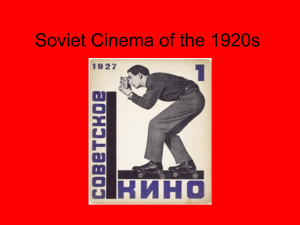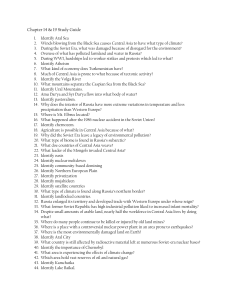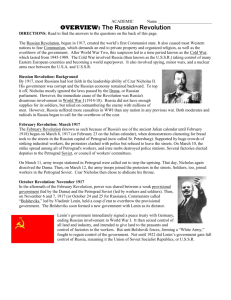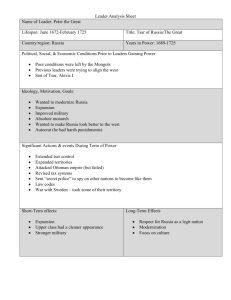File - Year 12 Revolutions Revision
advertisement
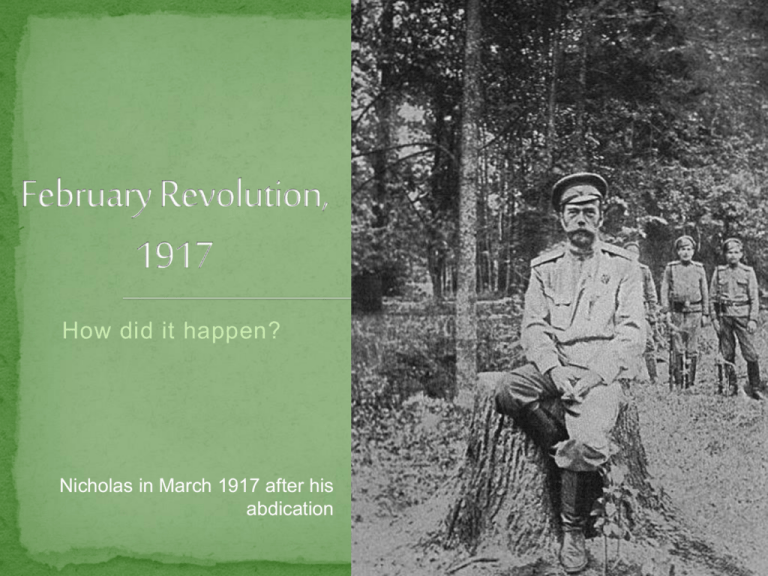
How did it happen? Nicholas in March 1917 after his abdication In January 1917 the Tsar received 3 warnings about the negative atmosphere in Petrograd: 1. 2. 3. Okhrana state the people hate the war, shortages, and are highly critical of the govt. In comparison to 1917, ‘1905 was but a toy’ Mikhail Rodzianko, chairman of the Duma warns that forced to choose between the Tsar and Russia, the people will choose Russia British Ambassador George Buchanan actually warns that a revolution is near, and will incorporate the people and the army Tsar at Mogilev Food and fuel shortages Factories shut down Poor transport-supplies can’t get through Germans aid Lenin in order to get Russia to pull out of war (Pipes, p.115) Julian Gregoria Calenda n r Calendar Key Crisis or event in Petrograd 18 Feb 3 March 20,000 workers strike at Putilov steel works 23 Feb 8 March 90,000 protestors at International Women’s day march 24 Feb 9 Mar 200,000 workers on strike. Soldiers patrol city 25 Feb 10 Mar Strikes closes entire city 26 Feb 11 Mar Soldiers join protesters, firing on police. Tsar does not believe Rodzianko’s warnings of revolution, 27 Feb 12 Mar The entire army revolts and the Duma forms the Provisional Committee 28 Feb 13 Mar Fighting between soldiers and loyal police. Prov Committee declare themselves the Prov Government. Petrograd Soviet formed by workers & soldiers 1 March 14 Mar Petrograd Soviet assert control; Tsar allows Prov Govt and starts return journey to Petrograd 2 March 15 Mar Tsar abdicates; Prov Govt takes control of Russia 3 March 16 Mar Fighting ends. Grand Duke Mikhail abdicates ending 300 Provisional Government vs. Petrograd Soviet Formed on the same day, the Provisional Government were the official authority with formal power, and the Petrograd Soviet who had the genuine power in the eyes of the people Between the revolutions the Dual governments worked together and were supported by the main revolutionary parties until Lenin arrived on April 3rd. Lenin launched a campaign to drive a wedge between the Soviet and Prov. Govt. Created by 12 men from the conservative 4th Duma. Not voted in Prince Lvov, a nobleman appointed PM Policies included many new civil liberties Organised to be replaced by an elected Constituent Assembly that represented all classes and all of Russia Read document p.43 of booklet Made of up over 3000 workers, soldiers and revolutionary party deputies. The soviet therefore influenced control of the army, railways, communications, employers and employees. Soviet Order 1 declared the defence force was answerable to the Soviet only Read document p.42 of booklet Lenin arrived back in Russia Germans helped him get back – it helped their war effort April Theses – renounce war, move to next stage of revolution, deny support to Prov. Govt. ‘all power to the Soviets’, dissolve army to create people’s militia, confiscate landlord’s property and nationalise land, single National bank to be created under Soviet supervision, Soviet control of production and distribution.’ Did mention patience twice – ‘it is not our immediate task to introduce socialism’ – Read p. 152 April 3 –Finland Station in Petrograd “ I cannot forget that speech, like a flash of lightning, which shook and astonished not only me, a heretic accidentally thrown into delirium, but also the true believers. I aver that on one had expected anything like it. It seemed as if all the elemental forces had risen from their lairs and the spirit of universal destruction, which knew no obstacles, no doubts, neither human difficulties nor human calculations, circled in Kshesinskaia’s hall above the heads of the enchanted disciples.’ Sukhanov ( a Menshevik) quoted in Pipes p. 117 Read document p.44 of booklet • Almost lead Russia into democracy • Before the June offensive was seen as the leader of the revolution to unify Russia • Was leader of the Socialist Revolutionaries • Belonged to the Provisional Government becoming PM in July • Also was Vice Chairman of the Petrograd Soviet • Nearly crushed Bolsheviks, Trotsky and Lenin from all existence BUT… 1. 2. 3. 4. 5. Only gained power thanks to triple abdication so had no popular mandate to rule Russia Continued the war everyone hated and were losing money from because of loans Russia owed to Allies Massive military defeat in June Offensive Focus on war meant economic problems continued Kerensky tried to please all sections of Russian society, which only managed to alienate them Factor 1: Lenin’s return via a train paid for by Germany and his April 3rd speech at Finland Station promising ‘Peace, Land, Bread!’ and ‘All power to the Soviets’ On the 4th April he put forward a blueprint for a Bolshevik revolution from the Provisional Government’s upper class democracy to a revolutionary dictatorship of workers and peasants Factor 2: July Days: On the verge of social and economic collapse, unemployed workers went to the streets in protest. It was put down by Kerensky’s troops after 3 days. The Bolsheviks were blamed and Lenin fled to Finland. Trotsky stayed to face the music and was arrested with many other Bolsheviks. They learned valuable lessons in how to take power. Factor 3: Kornilov Revolt: In August General Kornilov was appointed Commander in Chief of the Russian Army. His method to restore order was to march the army to Petrograd and replace the Prov. Govt. with a military dictatorship Kerensky had to free the Bolshevik prisoners to create an army to protect Petrograd Armed with weapons the Bolsheviks were now seen as the defenders of the revolution General Kornilov Factor 4: Growth in political support: Bolshevik support grew in Russian soviets due to growing demoralisation of the army From defending the revolution from the Kornilov revolt They were not tainted by association from the ineffectual Prov. Govt. Controlled the most powerful of Soviets in Petrograd and Moscow by September People trusted Trotsky and he became Chairman of the Petrograd Soviet The situation now seemed primed for a Bolshevik seizure of power Read document p.46 in booklet




